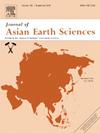Late Quaternary vertical throw rates along the Gyaring Co fault in central Tibet
IF 2.7
3区 地球科学
Q2 GEOSCIENCES, MULTIDISCIPLINARY
引用次数: 0
Abstract
Although normal components along the strike-slip faults have been widely found in central Tibet, poorly constrained vertical rates impede the recognition of their formation mechanism and tectonic implications. Herein, we systematically obtained spatial distribution of well-defined vertical throw rates along the Gyaring Co fault (GCF) using high-precision unmanned aerial vehicle topographic data and optically stimulated luminescence dating on oblique faulted fans and shorelines. Our integrated data indicated a southeastward decrease in Late Quaternary vertical throw rates from ∼0.12 to 0.05 mm/yr along the GCF. The vertical and horizontal movements of the GCF have shared similar rate gradient and have been partitioned with general steady ratios of 5–7.5 % since the Late Quaternary, which suggests that at least half of the motion on the GCF is accommodated by the southern linked Xainza rift. The vertical throws of the GCF are compatible with the conjugated Wuru Co fault, other strike-slip faults, and grabens in central Tibet but are tenfold slower than those of the southern linked rifts. Thus, our results indicate that the eastward motion of the conjugate strike-slip fault system could probably contribute to normal throws along the GCF. The disperse and slow normal faulting within the conjugate zones may initiated at the Middle Miocene as the secondary structures of the conjugate system in central Tibet, kinematically different from the considerably strong and independent southern linked rifts.
求助全文
约1分钟内获得全文
求助全文
来源期刊

Journal of Asian Earth Sciences
地学-地球科学综合
CiteScore
5.90
自引率
10.00%
发文量
324
审稿时长
71 days
期刊介绍:
Journal of Asian Earth Sciences has an open access mirror journal Journal of Asian Earth Sciences: X, sharing the same aims and scope, editorial team, submission system and rigorous peer review.
The Journal of Asian Earth Sciences is an international interdisciplinary journal devoted to all aspects of research related to the solid Earth Sciences of Asia. The Journal publishes high quality, peer-reviewed scientific papers on the regional geology, tectonics, geochemistry and geophysics of Asia. It will be devoted primarily to research papers but short communications relating to new developments of broad interest, reviews and book reviews will also be included. Papers must have international appeal and should present work of more than local significance.
The scope includes deep processes of the Asian continent and its adjacent oceans; seismology and earthquakes; orogeny, magmatism, metamorphism and volcanism; growth, deformation and destruction of the Asian crust; crust-mantle interaction; evolution of life (early life, biostratigraphy, biogeography and mass-extinction); fluids, fluxes and reservoirs of mineral and energy resources; surface processes (weathering, erosion, transport and deposition of sediments) and resulting geomorphology; and the response of the Earth to global climate change as viewed within the Asian continent and surrounding oceans.
 求助内容:
求助内容: 应助结果提醒方式:
应助结果提醒方式:


